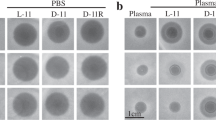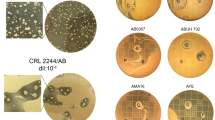Abstract
The peptidoglycan cell wall is an essential structure for the growth of most bacteria. However, many are capable of switching into a wall-deficient L-form state in which they are resistant to antibiotics that target cell wall synthesis under osmoprotective conditions, including host environments. L-form cells may have an important role in chronic or recurrent infections. The cellular pathways involved in switching to and from the L-form state remain poorly understood. This work shows that the lack of a cell wall, or blocking its synthesis with β-lactam antibiotics, results in an increased flux through glycolysis. This leads to the production of reactive oxygen species from the respiratory chain, which prevents L-form growth. Compensating for the metabolic imbalance by slowing down glycolysis, activating gluconeogenesis or depleting oxygen enables L-form growth in Bacillus subtilis, Listeria monocytogenes and Staphylococcus aureus. These effects do not occur in Enterococcus faecium, which lacks the respiratory chain pathway. Our results collectively show that when cell wall synthesis is blocked under aerobic and glycolytic conditions, perturbation of cellular metabolism causes cell death. We provide a mechanistic framework for many anecdotal descriptions of the optimal conditions for L-form growth and non-lytic killing by β-lactam antibiotics.
This is a preview of subscription content, access via your institution
Access options
Access Nature and 54 other Nature Portfolio journals
Get Nature+, our best-value online-access subscription
$29.99 / 30 days
cancel any time
Subscribe to this journal
Receive 12 digital issues and online access to articles
$119.00 per year
only $9.92 per issue
Buy this article
- Purchase on Springer Link
- Instant access to full article PDF
Prices may be subject to local taxes which are calculated during checkout






Similar content being viewed by others
Data availability
The data that support the findings of this study are available from the corresponding author on request.
References
Klieneberger, E. The natural occurrence of pleuropneumonia-like organisms in apparent symbiosis with Streptobacillus moniliformis and other bacteria. J. Pathol. Bacteriol. 40, 93–105 (1935).
Allan, E. J., Hoischen, C. & Gumpert, J. Bacterial L-forms. Adv. Appl. Microbiol. 68, 1–39 (2009).
Domingue, G. J. Sr. & Woody, H. B. Bacterial persistence and expression of disease. Clin. Microbiol. Rev. 10, 320–344 (1997).
Errington, J., Mickiewicz, K., Kawai, Y. & Wu, L. J. L-form bacteria, chronic diseases and the origins of life. Phil. Trans. R. Soc. B 371, 20150494 (2016).
Kawai, Y., Mickiewicz, K. & Errington, J. Lysozyme counteracts β-lactam antibiotics by promoting the emergence of L-form bacteria. Cell 172, 1038–1049 (2018).
Leaver, M., Dominguez-Cuevas, P., Coxhead, J. M., Daniel, R. A. & Errington, J. Life without a wall or division machine in Bacillus subtilis. Nature 457, 849–853 (2009).
Domínguez-Cuevas, P., Mercier, R., Leaver, M., Kawai, Y. & Errington, J. The rod to L-form transition of Bacillus subtilis is limited by a requirement for the protoplast to escape from the cell wall sacculus. Mol. Microbiol. 83, 52–66 (2012).
Mercier, R., Kawai, Y. & Errington, J. Excess membrane synthesis drives a primitive mode of cell proliferation. Cell 152, 997–1007 (2013).
Kawai, Y. et al. Cell growth of wall-free L-form bacteria is limited by oxidative damage. Curr. Biol. 25, 1613–1618 (2015).
Huber, T. W. & Brinkley, A. W. Growth of cell wall-defective variants of Escherichia coli: comparison of aerobic and anaerobic induction frequencies. J. Clin. Microbiol. 6, 166–171 (1977).
Jutras, B. L. & Jacobs-Wagner, C. Bacterial evolution: what goes around comes around. Curr. Biol. 25, R496–R498 (2015).
Willett, H. P. in Zinsser’s Microbiology 20th edn (eds Joklik, W. K., Willett, H. P. & Amos, D. B.) 53−75 (Appleton & Lange, 1992).
Van Schaik, W. et al. Pyrosequencing-based comparative genome analysis of the nosocomial pathogen Enterococcus faecium and identification of a large transferable pathogenicity island. BMC Genom. 11, 239 (2010).
Julsing, M. K., Rijpkema, M., Woerdenbag, H. J., Quax, W. J. & Kayser, O. Functional analysis of genes involved in the biosynthesis of isoprene in Bacillus subtilis. Appl. Microbiol. Biotechnol. 75, 1377–1384 (2007).
Blencke, H. M. et al. Transcriptional profiling of gene expression in response to glucose in Bacillus subtilis: regulation of the central metabolic pathways. Metab. Eng. 5, 133–149 (2003).
Winkler, W. C., Nahvi, A., Roth, A., Collins, J. A. & Breaker, R. R. Control of gene expression by a natural metabolite-responsive ribozyme. Nature 428, 281–286 (2004).
Gyan, S., Shiohira, Y., Sato, I., Takeuchi, M. & Sato, T. Regulatory loop between redox sensing of the NADH/NAD+ ratio by Rex (YdiH) and oxidation of NADH by NADH dehydrogenase Ndh in Bacillus subtilis. J. Bacteriol. 188, 7062–7071 (2006).
Santana, M. et al. Molecular cloning, sequencing, and physiological characterization of the qox operon from Bacillus subtilis encoding the aa 3-600 quinol oxidase. J. Biol. Chem. 267, 10225–10231 (1992).
Mogi, T. Over-expression and characterization of Bacillus subtilis heme O synthase. J. Biochem. 145, 669–675 (2009).
Töwe, S. et al. The MarR-type repressor MhqR (YkvE) regulates multiple dioxygenases/glyoxalases and an azoreductase which confer resistance to 2-methylhydroquinone and catechol in Bacillus subtilis. Mol. Microbiol. 66, 40–54 (2007).
Deutscher, J., Francke, C. & Postma, P. W. How phosphotransferase system-related protein phosphorylation regulates carbohydrate metabolism in bacteria. Microbiol. Mol. Biol. Rev. 70, 939–1031 (2006).
Pereira, Y., Petit-Glatron, M. F. & Chambert, R. yveB, encoding endolevanase LevB, is part of the sacB−yveB−yveA levansucrase tricistronic operon in Bacillus subtilis. Microbiology 147, 3413–3419 (2001).
Görke, B. & Stülke, J. Carbon catabolite repression in bacteria: many ways to make the most out of nutrients. Nat. Rev. Microbiol. 6, 613–624 (2008).
Kleijn, R. J. et al. Metabolic fluxes during strong carbon catabolite repression by malate in Bacillus subtilis. J. Biol. Chem. 285, 1587–1596 (2010).
Schilling, O. et al. Transcriptional and metabolic responses of Bacillus subtilis to the availability of organic acids: transcription regulation is important but not sufficient to account for metabolic adaptation. Appl. Environ. Microbiol. 73, 499–507 (2007).
Lovering, A. L., Safadi, S. S. & Strynadka, N. C. Structural perspective of peptidoglycan biosynthesis and assembly. Annu. Rev. Biochem. 81, 451–478 (2012).
Kawai, Y., Mercier, R. & Errington, J. Bacterial cell morphogenesis does not require a preexisting template structure. Curr. Biol. 24, 863–867 (2014).
Drummen, G. P., van Liebergen, L. C., Op den Kamp, J. A. & Post, J. A. C11-BODIPY581/591, an oxidation-sensitive fluorescent lipid peroxidation probe: (micro)spectroscopic characterization and validation of methodology. Free Radic. Biol. Med. 33, 473–490 (2002).
Chubukov, V. et al. Transcriptional regulation is insufficient to explain substrate-induced flux changes in Bacillus subtilis. Mol. Syst. Biol. 9, 709 (2013).
Chandrangsu, P., Loi, V. V., Antelmann, H. & Helmann, J. D. The role of bacillithiol in Gram-positive Firmicutes. Antioxid. Redox Signal. 28, 445–462 (2018).
Wu, J. A., Kusuma, C., Mond, J. J. & Kokai-Kun, J. F. Lysostaphin disrupts Staphylococcus aureus and Staphylococcus epidermidis biofilms on artificial surfaces. Antimicrob. Agents Chemother. 47, 3407–3414 (2003).
Han, J. et al. Glycerol uptake is important for L-form formation and persistence in Staphylococcus aureus. PLoS ONE 9, e108325 (2014).
Mercier, R., Kawai, Y. & Errington, J. General principles for the formation and proliferation of a wall-free (L-form) state in bacteria. eLife 3, e04629 (2014).
Cho, H., Uehara, T. & Bernhardt, T. G. Beta-lactam antibiotics induce a lethal malfunctioning of the bacterial cell wall synthesis machinery. Cell 159, 1300–1311 (2014).
Rae, C. S., Geissler, A., Adamson, P. C. & Portnoy, D. A. Mutations of the Listeria monocytogenes peptidoglycan N-deacetylase and O-acetylase result in enhanced lysozyme sensitivity, bacteriolysis, and hyperinduction of innate immune pathways. Infect. Immun. 79, 3596–3606 (2011).
Burke, T. P. et al. Listeria monocytogenes is resistant to lysozyme through the regulation, not the acquisition, of cell wall-modifying enzymes. J. Bacteriol. 196, 3756–3767 (2014).
Rodríguez-Tébar, A., Rojo, F. & Vazquez, D. Interaction of β-lactam antibiotics with penicillin-binding proteins from Bacillus megaterium. Eur. J. Biochem. 126, 161–166 (1982).
Kohanski, M. A., Dwyer, D. J., Hayete, B., Lawrence, C. A. & Collins, J. J. A common mechanism of cellular death induced by bactericidal antibiotics. Cell 130, 797–810 (2007).
Dwyer, D. J., Collins, J. J. & Walker, G. C. Unraveling the physiological complexities of antibiotic lethality. Annu. Rev. Pharmacol. Toxicol. 55, 313–332 (2015).
Van Acker, H. & Coenye, T. The role of reactive oxygen species in antibiotic-mediated killing of bacteria. Trends Microbiol. 25, 456–466 (2017).
Lobritz, M. A. et al. Antibiotic efficacy is linked to bacterial cellular respiration. Proc. Natl Acad. Sci. USA 112, 8173–8180 (2015).
Belenky, P. et al. Bactericidal antibiotics induce toxic metabolic perturbations that lead to cellular damage. Cell Rep. 13, 968–980 (2015).
Ladjouzi, R. et al. Loss of antibiotic tolerance in Sod-deficient mutants is dependent on the energy source and arginine catabolism in Enterococci. J. Bacteriol. 197, 3283–3293 (2015).
Dienes, L. & Weinberger, H. J. The L forms of bacteria. Bacteriol. Rev. 15, 245–288 (1951).
Spizizen, J. Transformation of biochemically deficient strains of Bacillus subtilis by deoxyribonucleate. Proc. Natl Acad. Sci. USA 44, 1072–1078 (1958).
Adams, D. W., Wu, L. J., Czaplewski, L. G. & Errington, J. Multiple effects of benzamide antibiotics on FtsZ function. Mol. Microbiol. 80, 68–84 (2011).
Vagner, V., Dervyn, E. & Ehrlich, S. D. A vector for systematic gene inactivation in Bacillus subtilis. Microbiology 144, 3097–3104 (1998).
Quisel, J. D., Burkholder, W. F. & Grossman, A. D. In vivo effects of sporulation kinases on mutant Spo0A proteins in Bacillus subtilis. J. Bacteriol. 183, 6573–6578 (2001).
Agapova, A. et al. Flexible nitrogen utilisation by the metabolic generalist pathogen Mycobacterium tuberculosis. eLife 8, e41129 (2019).
Larrouy-Maumus, G. et al. Cell-envelope remodeling as a determinant of phenotypic antibacterial tolerance in Mycobacterium tuberculosis. ACS Infect. Dis. 2, 352–360 (2016).
Acknowledgements
We thank P. Cossart for the L. monocytogenes strains. All work in the Errington lab was funded by a European Research Council award (grant no. 670980). Work in the L.P.S.d.C. lab was supported by a Wellcome Trust New Investigator Award (104785/B/14/Z). The L.P.S.d.C. lab is also funded by the Francis Crick Institute, which receives its core funding from Cancer Research UK (FC001060), the UK Medical Research Council (FC001060) and the Wellcome Trust (FC001060).
Author information
Authors and Affiliations
Contributions
Y.K. performed and analysed most of the experiments. R.M. and K.M. contributed strain constructions and preliminary genetic and microscopic experiments. A.S. and L.P.S.d.C. performed and analysed the metabolome and mass spectrometry experiments. All authors contributed to the experimental design and concepts. Y.K. and J.E. wrote the main text with contributions from all other authors.
Corresponding authors
Ethics declarations
Competing interests
The authors declare no competing interests.
Additional information
Publisher’s note: Springer Nature remains neutral with regard to jurisdictional claims in published maps and institutional affiliations.
Supplementary Information
Supplementary Information
Supplementary Figs. 1–4, Legend for Supplementary Video 1, Supplementary Tables 1–3 and Supplementary References.
Supplementary Video 1
Contrasting effects of glucose and succinate on L-form death/growth phenotype (related to Fig. 3).
Rights and permissions
About this article
Cite this article
Kawai, Y., Mercier, R., Mickiewicz, K. et al. Crucial role for central carbon metabolism in the bacterial L-form switch and killing by β-lactam antibiotics . Nat Microbiol 4, 1716–1726 (2019). https://doi.org/10.1038/s41564-019-0497-3
Received:
Accepted:
Published:
Issue Date:
DOI: https://doi.org/10.1038/s41564-019-0497-3
This article is cited by
-
(p)ppGpp modifies RNAP function to confer β-lactam resistance in a peptidoglycan-independent manner
Nature Microbiology (2024)
-
Direct observation of a crescent-shape chromosome in expanded Bacillus subtilis cells
Nature Communications (2024)
-
On the mechanisms of lysis triggered by perturbations of bacterial cell wall biosynthesis
Nature Communications (2023)
-
Collateral sensitivity to pleuromutilins in vancomycin-resistant Enterococcus faecium
Nature Communications (2022)
-
Outer membrane protein A (OmpA) as a potential therapeutic target for Acinetobacter baumannii infection
Journal of Biomedical Science (2020)



